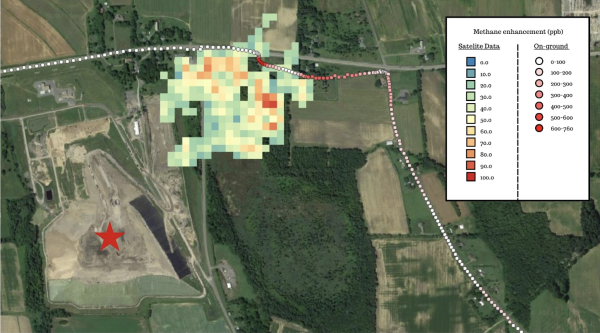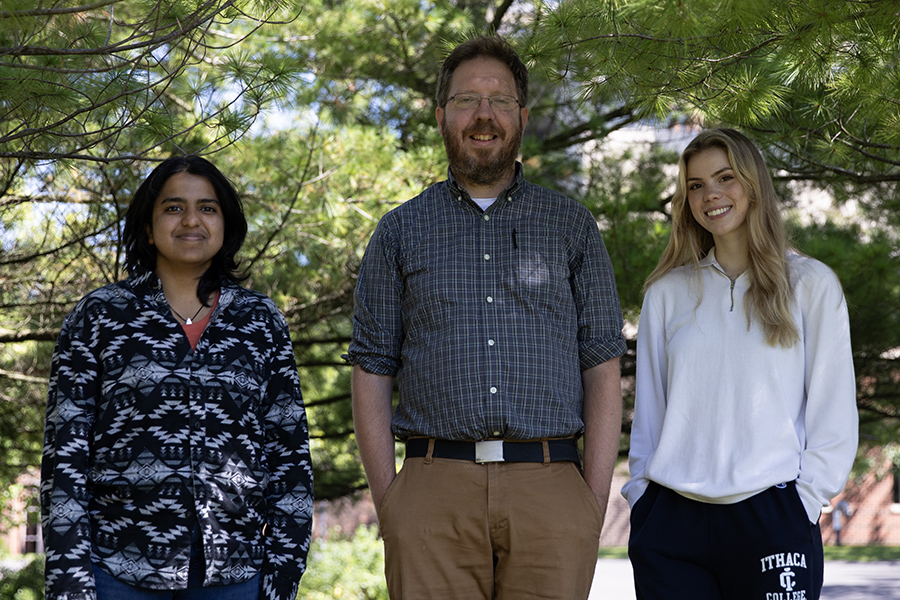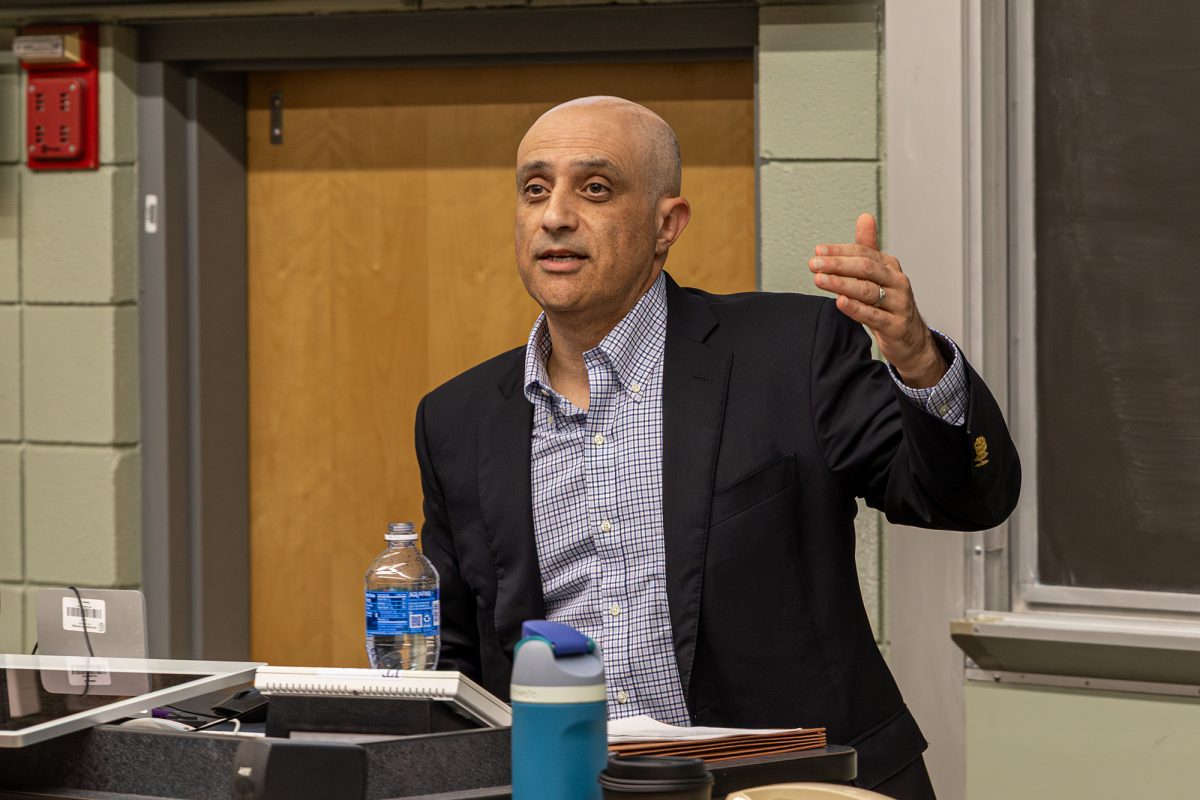Ithaca College students studying areas of science had the opportunity to work with a professor on a New York state-funded methane study. The college’s Summer Scholars Program provided an outlet for this research.
Juniors Daveigh Robbins and Nandini Agarwal worked with Eric Leibensperger, assistant professor in the Department of Physics and Astronomy, on his research on methane in Tompkins County and throughout the state. Robbins is a physics 3-2 engineering major and Agarwal is an environmental science major with a physics minor. Both applied for the Summer Scholars Program and got placed with Leibensperger to work on this research for eight weeks in summer 2023.
The application process requires applicants to express interest in specific professors’ research projects and explain why they are interested in doing the program itself. The program is available to students in any department interested in paid summer research.
Leibensperger has been involved in methane research in New York since 2016. Initially, he worked with a collaborator from the University of Rochester and set up sites on Whiteface Mountain in the Adirondacks and in Pinnacle State Park, as well as other locations across the state. Since then, he has worked with other students on this research, including seniors Jacob Cooney, Matthew Weil and Muhtasim Hossain ’22.
Since the research is done across New York, Ithaca College has been able to collaborate with students and faculty at other colleges and universities. Faculty and students from Ithaca College have worked with the University of Rochester University, Cornell University, the University of Albany and Columbia University.
Weil, a senior physics major with minors in computer science and data science, said how impactful this aspect of the research is.
“Working in a collaborative setting with other students and professors at different universities has been an amazing experience due to the unique and intricate perspectives each individual brings to the table,” Weil said. “Everyone has different ideas and comes from different backgrounds, so by being able to combine all these perspectives, I not only learn new techniques and knowledge, but we are able to combine ideas to determine the best and most efficient manner of completing a task.”
The research is sponsored by NYSERDA and the research groups from the various schools have regular meetings with NYSERDA where they discuss the data they have collected. The state wants to have a better picture of where the emissions are coming from and how much is coming from each place.
Methane is one of the most potent greenhouse gases. CO2 typically receives much attention for being a harmful greenhouse gas, however, it is actually less potent than methane. The reason for CO2’s publicity is that it stays in the atmosphere longer. According to research conducted by NASA’s Global Climate Change program, CO2 stays in the atmosphere for 300–1,000 years. Leibensperger said there is a difference in the longevity of CO2 and methane.
“Methane stays in the air for about a decade so when it comes out of a tailpipe, it takes about 10 years for it to go away on average, whereas CO2 is going to be a problem for centuries,” Leibensperger said.
However, this does not make methane any less harmful. According to Leibensperger’s research and the studies at the New York State Energy Research and Development Authority, methane has more warming power and contributes greatly to the climate crisis. Many state governments measure methane emissions over a span of 100 years. However, according to New York’s climate plan, methane emissions are measured over 20 years. This shorter time span allows for more accurate research and a more climate-forward community. New York hopes to reduce greenhouse gas emissions by 85% by 2050, according to the New York Climate Leadership and Community Protection Act.
Leibensperger and his students went to a dairy farm, landfill and salt mine to conduct their research. At the dairy farms, there are giant pits of manure called lagoons. According to the United States Environmental Protection Agency, manure is one of the leading emitters of methane in the world. Leibensperger said the research team walked around the lagoons 10 times to record data.
Salt mines and the process in which garbage breaks down at the landfills emit methane as well. For the landfill and salt mine, they conducted mobile sampling. They placed detectors in a van and drove around 10 times to locate peak points of emissions.
The data collection is done through the use of various technologies. One of the devices they use is the DJI Matrice 600 Pro drone. This drone has an internal GPS that helps the researchers pinpoint the exact locations of strong plumes of methane. Leibensperger said the drone helps them record more accurate data.
“To figure out what’s above us or how big a plume of pollution is coming from a certain source, we fly drones,” Leibensperger said. “We put some analyzers on the drone and we fly it up in the plume to measure the extent of the plume.”
Agarwal also worked with the drone many times, attaching the analyzer to the drone and then flying it at the different sites.
“The reason we have been using the drones is to get a vertical profile,” Agarwal said. “If we see the peak is three meters wide on the ground, we don’t know how high it extends, so the drone will tell us the exact quantity of gas that is being emitted.”
The researchers also put on LI-COR backpacks, which had analyzers in them as well. Agarwal said the LI-COR is heavy to wear during their long studies in the field, but the data collected was valuable. Since the process consisted of walking around the lagoon 10 times, the weight of the equipment made the process strenuous.
In addition to the technology used to collect the data, there are also programs used to help compile the data. R and QGIS are forms of mapping software used to organize the data. Robbins said the software creates helpful visual maps that make data collection more organized.
“There is a color gradient on the map and a legend that shows what color corresponds with how concentrated [the methane] is,” Robbins said. “The colors will change and you can see where the plumes and the spikes are.”

Robbins, Agarwal and Weil all reflected on their Summer Scholars Program positively. Robbins said she recommends that other students apply for the program in summer 2024.
“It was a really great experience not only for putting myself out there and getting an idea of what I would be doing outside Ithaca College, but you also get a greater sense of belonging at the college itself,” Robbins said.










